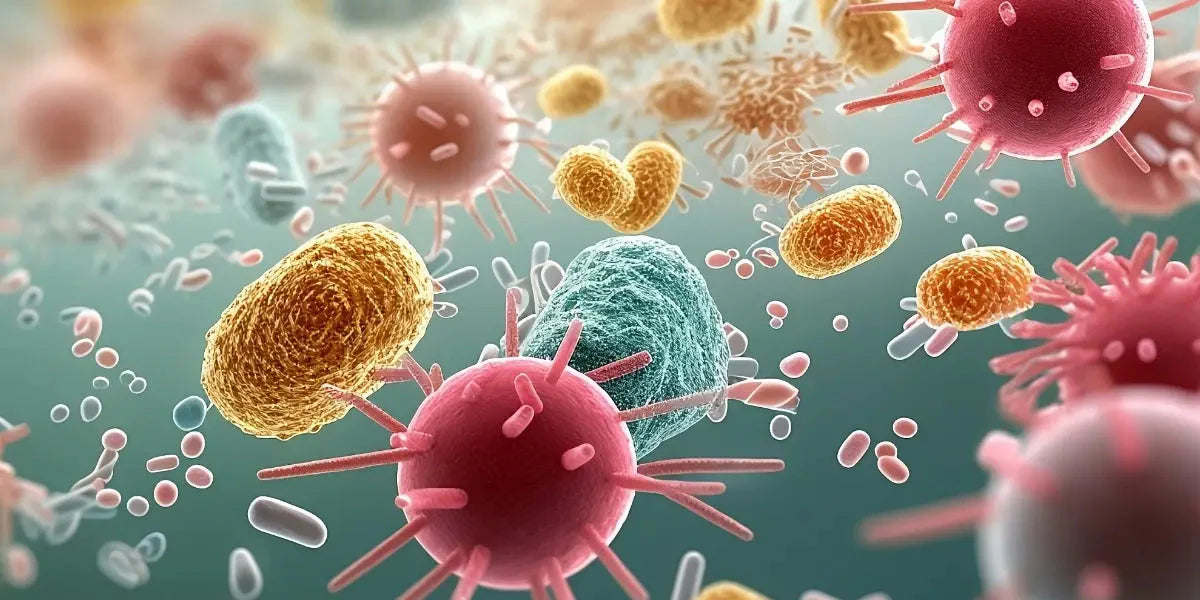Understanding how our immune system works is no easy task. It is a complex network of cells, tissues and organs that work together to defend us against attacks by dangerous microorganisms such as bacteria, viruses and parasites.
The different actors of the immune system
It is made up of several different immune cells that work together to protect us from foreign invasions.
One of the main players in the immune system is the white blood cell or leukocyte. White blood cells are essential for our immune defense because they are responsible for destroying foreign bodies. There are different types of white blood cells, including lymphocytes and phagocytes .
Lymphocytes are among the most important in our immune system. They are divided into two main types: B lymphocytes and T lymphocytes. B lymphocytes transform into antibody-producing cells in the presence of a pathogen, thus producing specific antibodies . These antibodies are able to bind to specific pathogens, helping the immune system destroy them. T lymphocytes, on the other hand, help eliminate cells infected by viruses.
Phagocytes are another category of white blood cells. They specialize in devouring infected or dead cells, cellular debris and pathogens, thereby helping to keep the body clean. The two most common types of phagocytes are neutrophils and macrophages.
In addition to white blood cells, our body also has immune system proteins that are essential for our body's defense. These proteins include cytokines, which are chemical messengers that help coordinate the immune response, and complements, which help improve the immune system's ability to destroy pathogens.
The innate immune system: the immediate response to attackers
Our body's first line of defense against infections is the innate immune system . It is an immediate and non-specific response to the first sign of invasion by pathogenic microorganisms. Its components are ready and capable of combating a wide range of potentially harmful threats.
The innate immune system consists of a variety of natural killer (NK) cells , macrophages , and dendritic cells . Natural killer cells are a type of white blood cell that can recognize and destroy certain cells infected by viruses and certain cancer cells. Macrophages can ingest and destroy microorganisms, while dendritic cells play a key role in activating the adaptive immune system.
The innate immune system also includes physical and chemical barriers , such as the skin and mucous membranes, which prevent the invasion of many microorganisms. Chemicals in our blood, like complement and interferon , also help fight infections.

The adaptive immune system: a specific and targeted response
Where the innate immune system is our first line of defense, broad and non-specific, the adaptive immune system provides targeted and specific defense against attackers. Unlike the innate immune system, it takes time to develop after initial exposure to a specific microbe.
The adaptive immune system is divided into two main subparts: cell-mediated immunity and humoral immunity.
Cell-mediated immunity
In cell-mediated immunity , T lymphocytes , a type of white blood cell, play a key role. They specifically recognize cells in our body infected by viruses or bacteria and destroy them.
They do this by recognizing antigens, foreign substances present on the surface of microbes or infected cells. Each T cell is programmed to recognize a specific antigen. Once they recognize the antigen, they multiply to form an army of T cells and launch their attack.
Humoral immunity
Humoral immunity involves B lymphocytes , another type of white blood cell. Their job is to produce antibodies, proteins that bind specifically to antigens to help neutralize them.
Each B cell is also programmed to recognize a specific antigen. When they encounter this antigen, they turn into antibody-producing cells also called plasma cells . These antibodies then circulate in the blood and lymph to find and neutralize the specific antigen.
Immune memory: remembering to better defend yourself
Perhaps the most fascinating aspect of the immune system is its ability to remember past infections. This feature, known as immune memory , allows our body to defend itself more effectively against future infections.
When you are first exposed to a pathogen, it takes a relatively long time for your immune system to develop an appropriate response. It is during this period that you may feel sick. However, if you are exposed to the same pathogen again, your immune system may remember how it fought off the previous infection and respond much more quickly.
Immune memory is mainly caused by two types of cells: B lymphocytes and T lymphocytes . B lymphocytes produce specific antibodies against a given pathogen. Once the infection clears, most of these cells die, but some survive as memory B cells . These cells are able to remember the pathogen and quickly produce antibodies if they encounter that pathogen again.
T lymphocytes, for their part, are responsible for the direct destruction of infected cells. Like B cells, T cells produce memory T cells after infection.
Conclusion
Understanding the immune system is essential to understanding our ability to deal with diseases and infections. From the innate immune system, which provides immediate but non-specific defense, to the adaptive immune system that learns and remembers specific attackers, our bodies are incredibly adept at defending themselves.




